child restraint MAZDA MODEL RX 8 2006 (in English) User Guide
[x] Cancel search | Manufacturer: MAZDA, Model Year: 2006, Model line: MODEL RX 8, Model: MAZDA MODEL RX 8 2006Pages: 434
Page 37 of 434
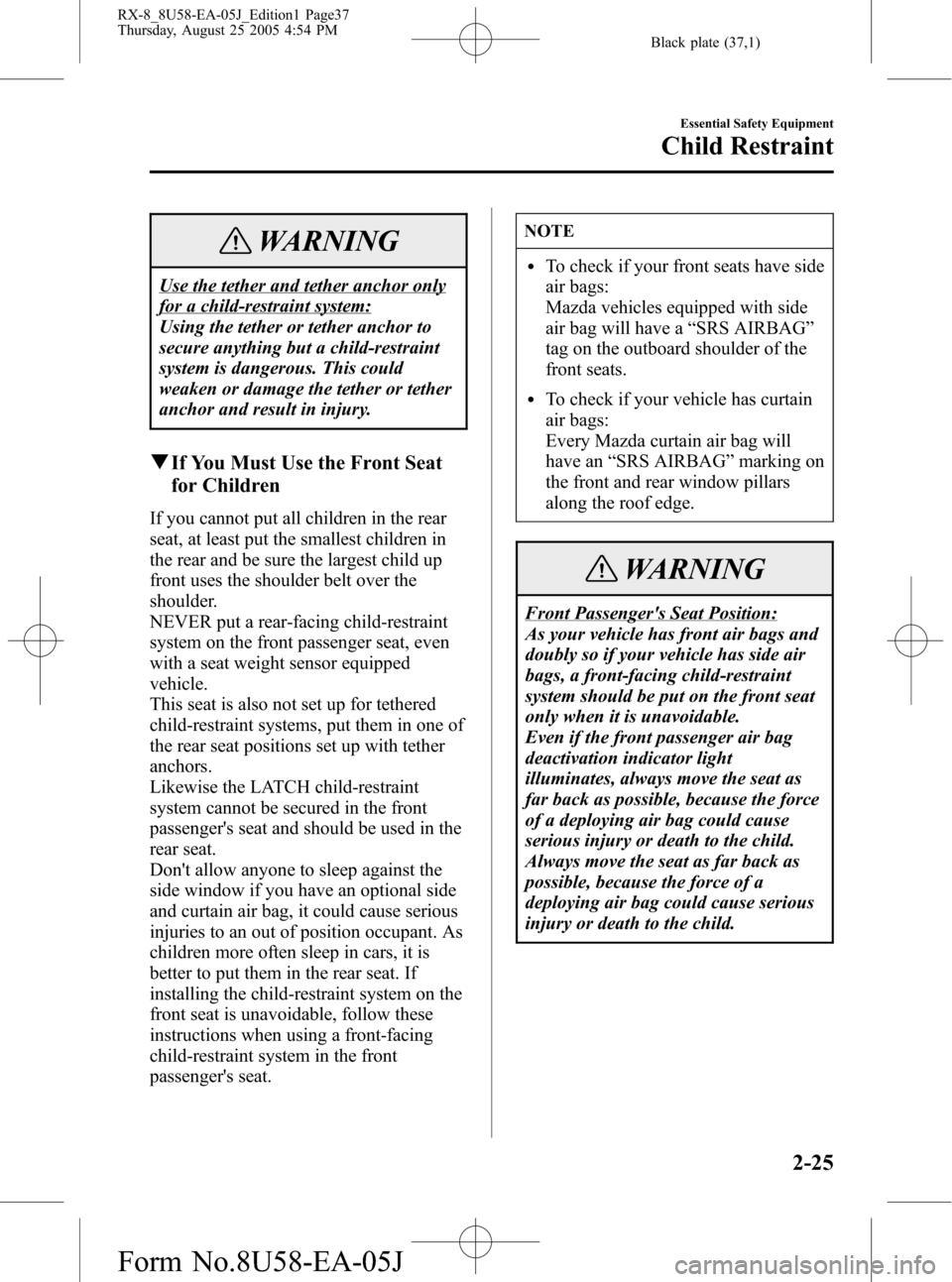
Black plate (37,1)
WARNING
Use the tether and tether anchor only
for a child-restraint system:
Using the tether or tether anchor to
secure anything but a child-restraint
system is dangerous. This could
weaken or damage the tether or tether
anchor and result in injury.
qIf You Must Use the Front Seat
for Children
If you cannot put all children in the rear
seat, at least put the smallest children in
the rear and be sure the largest child up
front uses the shoulder belt over the
shoulder.
NEVER put a rear-facing child-restraint
system on the front passenger seat, even
with a seat weight sensor equipped
vehicle.
This seat is also not set up for tethered
child-restraint systems, put them in one of
the rear seat positions set up with tether
anchors.
Likewise the LATCH child-restraint
system cannot be secured in the front
passenger's seat and should be used in the
rear seat.
Don't allow anyone to sleep against the
side window if you have an optional side
and curtain air bag, it could cause serious
injuries to an out of position occupant. As
children more often sleep in cars, it is
better to put them in the rear seat. If
installing the child-restraint system on the
front seat is unavoidable, follow these
instructions when using a front-facing
child-restraint system in the front
passenger's seat.
NOTE
lTo check if your front seats have side
air bags:
Mazda vehicles equipped with side
air bag will have a“SRS AIRBAG”
tag on the outboard shoulder of the
front seats.
lTo check if your vehicle has curtain
air bags:
Every Mazda curtain air bag will
have an“SRS AIRBAG”marking on
the front and rear window pillars
along the roof edge.
WARNING
Front Passenger's Seat Position:
As your vehicle has front air bags and
doubly so if your vehicle has side air
bags, a front-facing child-restraint
system should be put on the front seat
only when it is unavoidable.
Even if the front passenger air bag
deactivation indicator light
illuminates, always move the seat as
far back as possible, because the force
of a deploying air bag could cause
serious injury or death to the child.
Always move the seat as far back as
possible, because the force of a
deploying air bag could cause serious
injury or death to the child.
Essential Safety Equipment
Child Restraint
2-25
RX-8_8U58-EA-05J_Edition1 Page37
Thursday, August 25 2005 4:54 PM
Form No.8U58-EA-05J
Page 38 of 434
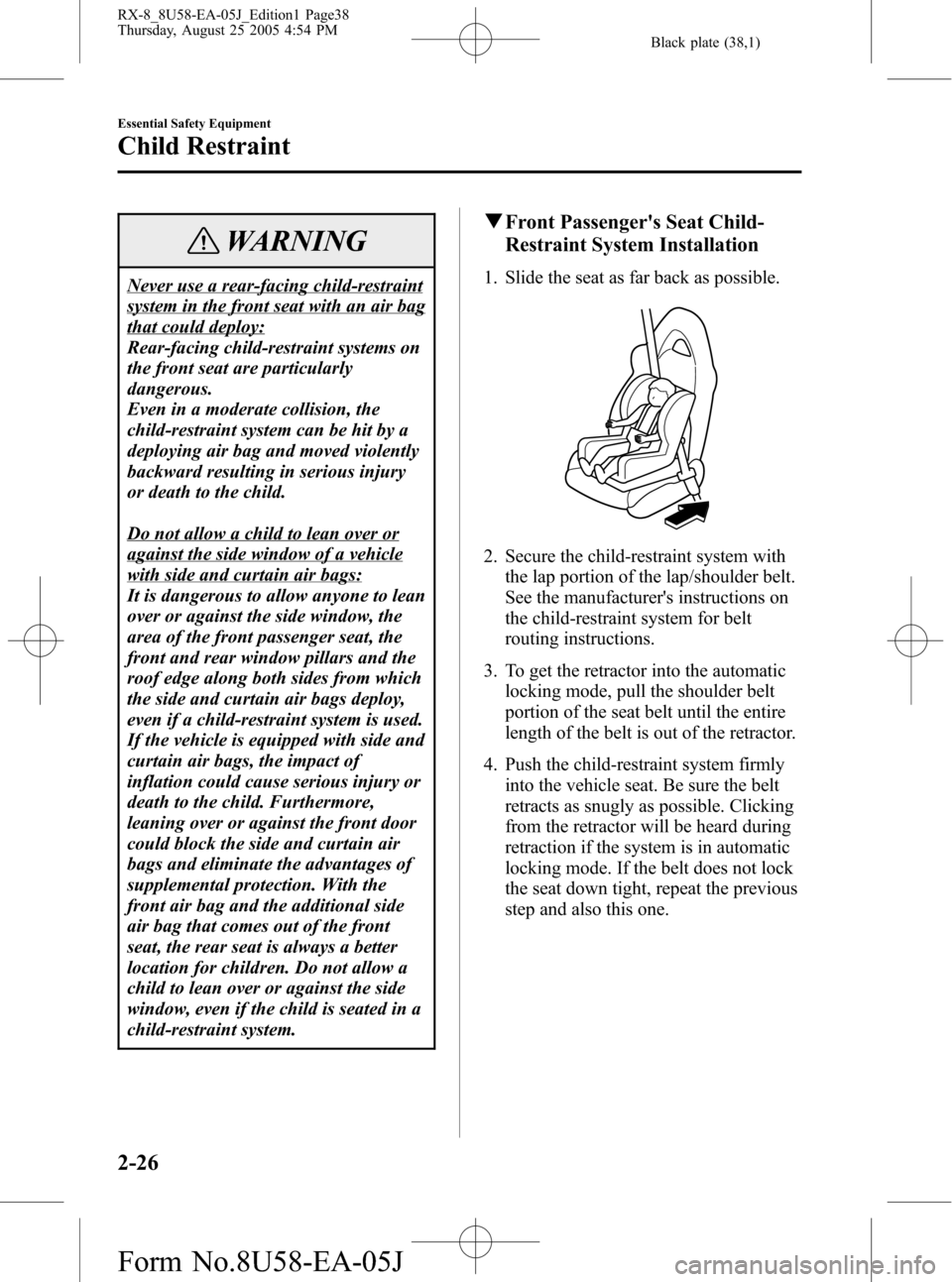
Black plate (38,1)
WARNING
Never use a rear-facing child-restraint
system in the front seat with an air bag
that could deploy:
Rear-facing child-restraint systems on
the front seat are particularly
dangerous.
Even in a moderate collision, the
child-restraint system can be hit by a
deploying air bag and moved violently
backward resulting in serious injury
or death to the child.
Do not allow a child to lean over or
against the side window of a vehicle
with side and curtain air bags:
It is dangerous to allow anyone to lean
over or against the side window, the
area of the front passenger seat, the
front and rear window pillars and the
roof edge along both sides from which
the side and curtain air bags deploy,
even if a child-restraint system is used.
If the vehicle is equipped with side and
curtain air bags, the impact of
inflation could cause serious injury or
death to the child. Furthermore,
leaning over or against the front door
could block the side and curtain air
bags and eliminate the advantages of
supplemental protection. With the
front air bag and the additional side
air bag that comes out of the front
seat, the rear seat is always a better
location for children. Do not allow a
child to lean over or against the side
window, even if the child is seated in a
child-restraint system.
qFront Passenger's Seat Child-
Restraint System Installation
1. Slide the seat as far back as possible.
2. Secure the child-restraint system with
the lap portion of the lap/shoulder belt.
See the manufacturer's instructions on
the child-restraint system for belt
routing instructions.
3. To get the retractor into the automatic
locking mode, pull the shoulder belt
portion of the seat belt until the entire
length of the belt is out of the retractor.
4. Push the child-restraint system firmly
into the vehicle seat. Be sure the belt
retracts as snugly as possible. Clicking
from the retractor will be heard during
retraction if the system is in automatic
locking mode. If the belt does not lock
the seat down tight, repeat the previous
step and also this one.
2-26
Essential Safety Equipment
Child Restraint
RX-8_8U58-EA-05J_Edition1 Page38
Thursday, August 25 2005 4:54 PM
Form No.8U58-EA-05J
Page 39 of 434

Black plate (39,1)
NOTE
lInspect this function before each use
of the child-restraint system. You
should not be able to pull the
shoulder belt out of the retractor
while the system is in the automatic
locking mode. When you remove the
child-restraint system, be sure the
belt fully retracts to return the system
to emergency locking mode before
occupants use the seat belts.
lFollow the child-restraint system
manufacturer's instructions carefully.
Depending on the type of child-
restraint system, it may not employ
seat belts which are in automatic
locking mode.
5. Make sure the front passenger air bag
deactivation indicator light illuminates
after installing a child-restraint system
on the front passenger seat.
Refer to Front passenger air bag
deactivation indicator light on page
2-37.
WARNING
Seating a Child in a Child-Restraint
System on the Front Passenger Seat
With the Front Passenger Air Bag
Deactivation Indicator Light Not
Illuminated:
While it is always better to install any
child-restraint system on the rear seat,
it is essential to do so if the front
passenger air bag deactivation
indicator light does not illuminate
(page 2-37). Seating a child in a child-
restraint system installed on the front
passenger seat with the front
passenger air bag deactivation
indicator light not illuminated is
dangerous. If this indicator light does
not illuminate even when the total
seated weight is less than
approximately 30 kg (66 lb), this
means that the front passenger front
and side air bags, and seat belt
pretensioner are ready for deployment.
If an accident were to deploy an air
bag, a child sitting in the front
passenger seat could be seriously
injured or killed. If the indicator light
does not illuminate after installing a
child-restraint system on the front
passenger seat, install the child-
restraint system on the rear seat and
consult an Authorized Mazda Dealer
as soon as possible.
Essential Safety Equipment
Child Restraint
2-27
RX-8_8U58-EA-05J_Edition1 Page39
Thursday, August 25 2005 4:54 PM
Form No.8U58-EA-05J
Page 40 of 434

Black plate (40,1)
LATCH Child-Restraint Systems
Your Mazda is equipped with LATCH lower anchors for attachment of specially designed
LATCH child-restraint systems in the rear seat. Both anchors must be used, otherwise the
seat will bounce around and put the child in danger. Most LATCH child-restraint systems
must also be used in conjunction with a tether to be effective. If they have a tether you
must use it to better assure your child's safety.
WARNING
Manufacturer's Instructions for Child-Restraint System:
An unsecured child-restraint system is dangerous. In a sudden stop or a collision it
could move causing serious injury or death to the child or other occupants. Make sure
the child-restraint system is properly secured in place according to the child-restraint
system manufacturer's instructions.
Unsecured Child-Restraint System:
An unsecured child-restraint system is dangerous. In a sudden stop or a collision it
could move causing serious injury or death to the child or other occupants. Follow the
child-restraint system manufacturer's instructions on belt routing to secure the seat
just as you would with a child in it so that nobody is tempted to put a child in an
improperly secured seat later on. When not in use, remove it from the vehicle or fasten
it with a seat belt, or latch it down to BOTH LATCH lower anchors for LATCH child-
restraint systems.
LATCH Child-Restraint Systems:
Not following the child-restraint system manufacturer's instructions when installing
the child-restraint system is dangerous. If seat belts or a foreign object prevent the
child-restraint system from being securely attached to the LATCH lower anchors and
the child-restraint system is installed improperly, the child-restraint system could move
in a sudden stop or collision causing serious injury or death to the child or other
occupants. When installing the child-restraint system, make sure there are no seat
belts or foreign objects near or around the LATCH lower anchors. Always follow the
child-restraint system manufacturer's instructions.
2-28
Essential Safety Equipment
Child Restraint
RX-8_8U58-EA-05J_Edition1 Page40
Thursday, August 25 2005 4:54 PM
Form No.8U58-EA-05J
Page 41 of 434

Black plate (41,1)
qLATCH Child-Restraint System
Installation Procedure (Rear Seats)
1. Expand the open seams on the rear of
the seat bottom slightly to verify the
locations of the LATCH lower anchors.
NOTE
The markings above the LATCH lower
anchors indicate the locations of
LATCH lower anchors for the
attachment of a child-restraint system.
2. Secure the child-restraint system using
BOTH LATCH lower anchors,
following the child-restraint system
manufacturer's instruction.
3. If your child-restraint system came
equipped with a tether, that probably
means it is very important to properly
secure the tether for child safety, please
carefully follow the child-restraint
system manufacturer's instructions
when installing tethers.Anchor bracket location
Tether strap position
Tether strap
Anchor
bracket
WARNING
Use the tether and tether anchor only
for a child-restraint system:
Using the tether or tether anchor to
secure anything but a child-restraint
system is dangerous. This could
weaken or damage the tether or tether
anchor and result in injury.
Essential Safety Equipment
Child Restraint
2-29
RX-8_8U58-EA-05J_Edition1 Page41
Thursday, August 25 2005 4:54 PM
Form No.8U58-EA-05J
Page 42 of 434
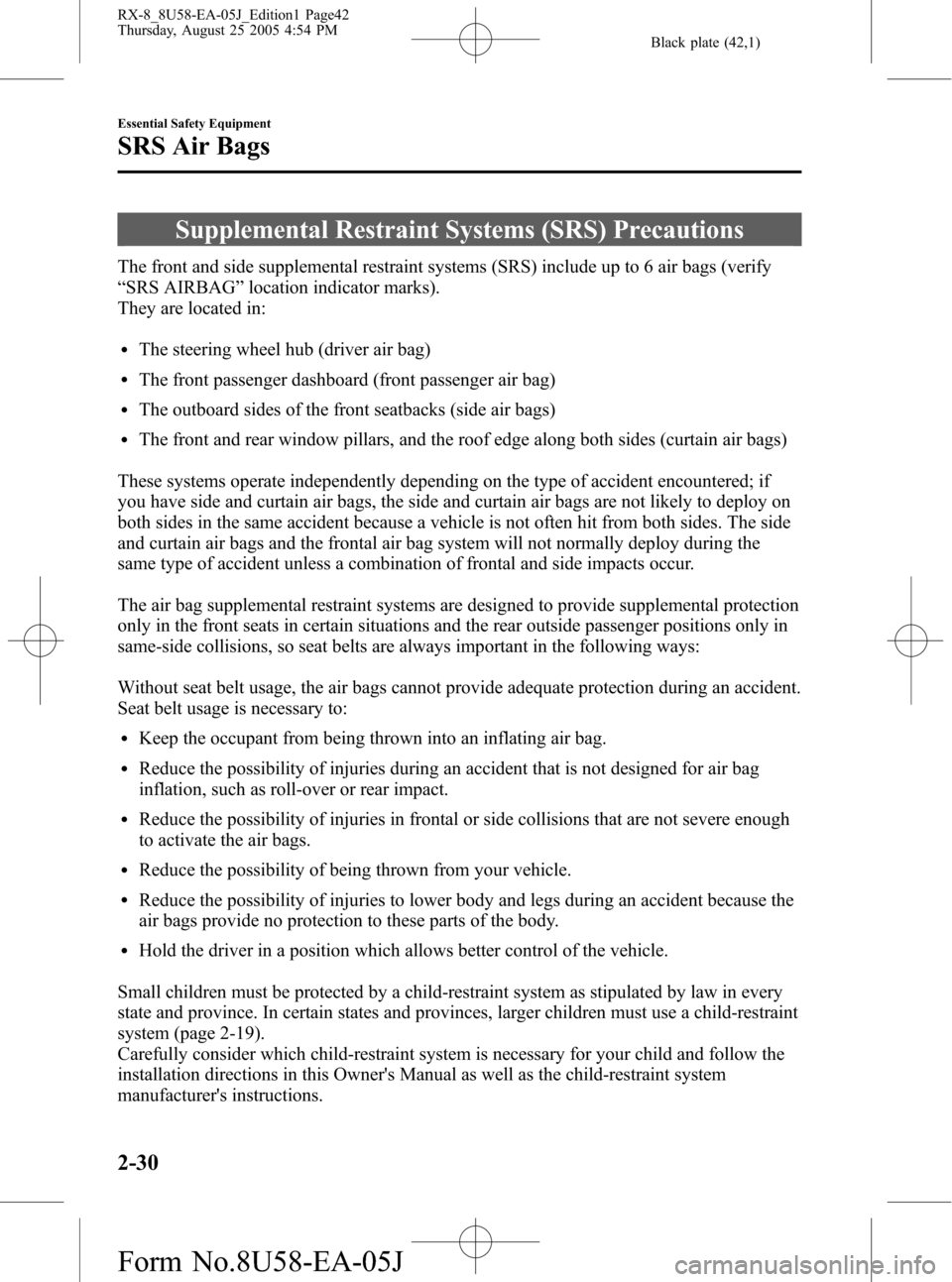
Black plate (42,1)
Supplemental Restraint Systems (SRS) Precautions
The front and side supplemental restraint systems (SRS) include up to 6 air bags (verify
“SRS AIRBAG”location indicator marks).
They are located in:
lThe steering wheel hub (driver air bag)
lThe front passenger dashboard (front passenger air bag)
lThe outboard sides of the front seatbacks (side air bags)
lThe front and rear window pillars, and the roof edge along both sides (curtain air bags)
These systems operate independently depending on the type of accident encountered; if
you have side and curtain air bags, the side and curtain air bags are not likely to deploy on
both sides in the same accident because a vehicle is not often hit from both sides. The side
and curtain air bags and the frontal air bag system will not normally deploy during the
same type of accident unless a combination of frontal and side impacts occur.
The air bag supplemental restraint systems are designed to provide supplemental protection
only in the front seats in certain situations and the rear outside passenger positions only in
same-side collisions, so seat belts are always important in the following ways:
Without seat belt usage, the air bags cannot provide adequate protection during an accident.
Seat belt usage is necessary to:
lKeep the occupant from being thrown into an inflating air bag.
lReduce the possibility of injuries during an accident that is not designed for air bag
inflation, such as roll-over or rear impact.
lReduce the possibility of injuries in frontal or side collisions that are not severe enough
to activate the air bags.
lReduce the possibility of being thrown from your vehicle.
lReduce the possibility of injuries to lower body and legs during an accident because the
air bags provide no protection to these parts of the body.
lHold the driver in a position which allows better control of the vehicle.
Small children must be protected by a child-restraint system as stipulated by law in every
state and province. In certain states and provinces, larger children must use a child-restraint
system (page 2-19).
Carefully consider which child-restraint system is necessary for your child and follow the
installation directions in this Owner's Manual as well as the child-restraint system
manufacturer's instructions.
2-30
Essential Safety Equipment
SRS Air Bags
RX-8_8U58-EA-05J_Edition1 Page42
Thursday, August 25 2005 4:54 PM
Form No.8U58-EA-05J
Page 43 of 434
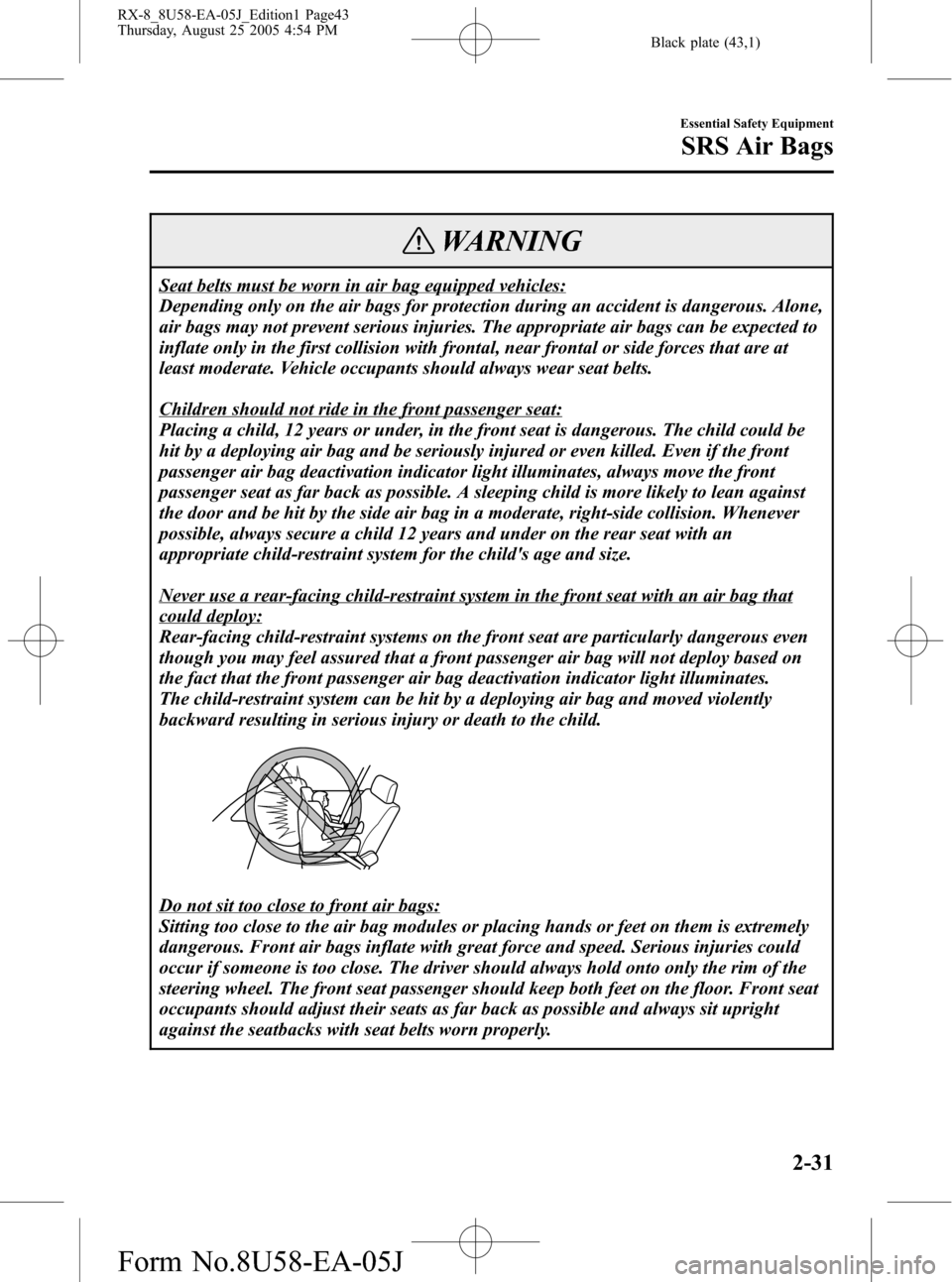
Black plate (43,1)
WARNING
Seat belts must be worn in air bag equipped vehicles:
Depending only on the air bags for protection during an accident is dangerous. Alone,
air bags may not prevent serious injuries. The appropriate air bags can be expected to
inflate only in the first collision with frontal, near frontal or side forces that are at
least moderate. Vehicle occupants should always wear seat belts.
Children should not ride in the front passenger seat:
Placing a child, 12 years or under, in the front seat is dangerous. The child could be
hit by a deploying air bag and be seriously injured or even killed. Even if the front
passenger air bag deactivation indicator light illuminates, always move the front
passenger seat as far back as possible. A sleeping child is more likely to lean against
the door and be hit by the side air bag in a moderate, right-side collision. Whenever
possible, always secure a child 12 years and under on the rear seat with an
appropriate child-restraint system for the child's age and size.
Never use a rear-facing child-restraint system in the front seat with an air bag that
could deploy:
Rear-facing child-restraint systems on the front seat are particularly dangerous even
though you may feel assured that a front passenger air bag will not deploy based on
the fact that the front passenger air bag deactivation indicator light illuminates.
The child-restraint system can be hit by a deploying air bag and moved violently
backward resulting in serious injury or death to the child.
Do not sit too close to front air bags:
Sitting too close to the air bag modules or placing hands or feet on them is extremely
dangerous. Front air bags inflate with great force and speed. Serious injuries could
occur if someone is too close. The driver should always hold onto only the rim of the
steering wheel. The front seat passenger should keep both feet on the floor. Front seat
occupants should adjust their seats as far back as possible and always sit upright
against the seatbacks with seat belts worn properly.
Essential Safety Equipment
SRS Air Bags
2-31
RX-8_8U58-EA-05J_Edition1 Page43
Thursday, August 25 2005 4:54 PM
Form No.8U58-EA-05J
Page 53 of 434
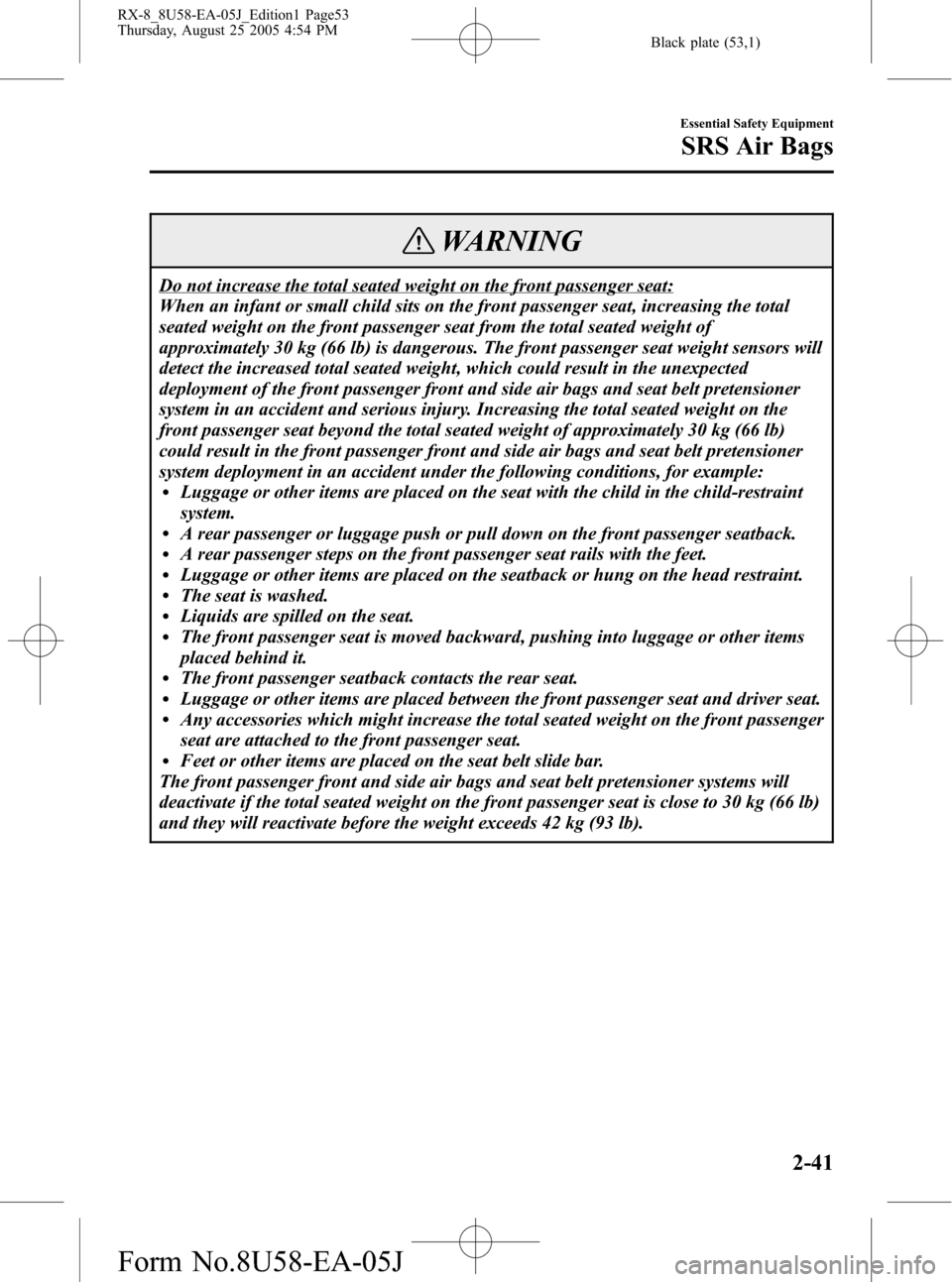
Black plate (53,1)
WARNING
Do not increase the total seated weight on the front passenger seat:
When an infant or small child sits on the front passenger seat, increasing the total
seated weight on the front passenger seat from the total seated weight of
approximately 30 kg (66 lb) is dangerous. The front passenger seat weight sensors will
detect the increased total seated weight, which could result in the unexpected
deployment of the front passenger front and side air bags and seat belt pretensioner
system in an accident and serious injury. Increasing the total seated weight on the
front passenger seat beyond the total seated weight of approximately 30 kg (66 lb)
could result in the front passenger front and side air bags and seat belt pretensioner
system deployment in an accident under the following conditions, for example:
lLuggage or other items are placed on the seat with the child in the child-restraint
system.
lA rear passenger or luggage push or pull down on the front passenger seatback.lA rear passenger steps on the front passenger seat rails with the feet.lLuggage or other items are placed on the seatback or hung on the head restraint.lThe seat is washed.lLiquids are spilled on the seat.lThe front passenger seat is moved backward, pushing into luggage or other items
placed behind it.
lThe front passenger seatback contacts the rear seat.lLuggage or other items are placed between the front passenger seat and driver seat.lAny accessories which might increase the total seated weight on the front passenger
seat are attached to the front passenger seat.
lFeet or other items are placed on the seat belt slide bar.
The front passenger front and side air bags and seat belt pretensioner systems will
deactivate if the total seated weight on the front passenger seat is close to 30 kg (66 lb)
and they will reactivate before the weight exceeds 42 kg (93 lb).
Essential Safety Equipment
SRS Air Bags
2-41
RX-8_8U58-EA-05J_Edition1 Page53
Thursday, August 25 2005 4:54 PM
Form No.8U58-EA-05J
Page 54 of 434

Black plate (54,1)
CAUTION
lTo assure proper deployment of the front air bag and to prevent damage to the sensors
in the front seat bottoms:
lDo not place sharp objects on the front seat bottoms or leave heavy luggage on
them.
lDo not spill any liquids on the front seats or under the front seats.
lTo allow the sensors to function properly, always perform the following:
lAdjust the front seats as far back as possible and always sit upright against the
seatbacks with seat belts worn properly.
lIf you place your child on the front passenger seat, secure the child-restraint system
properly and slide the front passenger seat as far back as possible (page 2-26).
NOTE
lThe system requires about 10 seconds to alternate between turning the front passenger
front and side air bags and seat belt pretensioner system on or off.
lThe front passenger air bag deactivation indicator light may illuminate repeatedly if
luggage or other items are put on the front passenger seat, or if the temperature of the
vehicle's interior changes suddenly.
lThe front passenger air bag deactivation indicator light may illuminate for 10 seconds
if the total seated weight on the front passenger seat changes.
lIf the front passenger air bag deactivation indicator light does not illuminate after
installing a child-restraint system on the front passenger seat, install the child-restraint
system on the rear seat and consult an Authorized Mazda Dealer as soon as possible.
Driver and front passenger buckle switches
The buckle switches on the front seat belts detect whether or not the front seat belts are
securely fastened and further control the deployment of the air bags.
2-42
Essential Safety Equipment
SRS Air Bags
RX-8_8U58-EA-05J_Edition1 Page54
Thursday, August 25 2005 4:54 PM
Form No.8U58-EA-05J
Page 375 of 434

Black plate (375,1)
C
Child Restraint
Child restraint precautions ......... 2-19
Installing child-restraint
systems ....................................... 2-23
LATCH child-restraint
systems ....................................... 2-28
Cigarette Lighter ............................... 6-43
Climate Control System ...................... 6-2
Gas specifications ...................... 10-5
Clock ................................................. 6-42
Coin Box ........................................... 6-46
Courtesy Lights ................................. 6-40
Cruise Control ................................... 5-19
Cup Holder ........................................ 6-45
Customer Assistance ........................... 9-2
D
Dashboard Illumination .................... 5-37
Daytime Running Lights ................... 5-55
Defroster
Rear window .............................. 5-59
Dimensions ....................................... 10-5
Door Locks ....................................... 3-28
Driving In Flooded Area ................... 4-11
Driving Tips ........................................ 4-7
Automatic transmission .............. 5-17
Break-in period ............................ 4-7
Driving in flooded area .............. 4-11
Hazardous driving ........................ 4-8
Money-saving suggestions ........... 4-7
Rocking the vehicle ...................... 4-9
Winter driving .............................. 4-9
Dynamic Stability Control (DSC) ..... 5-23
DSC OFF indicator light ............ 5-24
DSC OFF switch ........................ 5-25
TCS/DSC Indicator light ............ 5-24
E
Emergency Starting ........................... 7-20
Jump-starting .............................. 7-21
Push-starting .............................. 7-24
Emergency Towing ........................... 7-25
Emission Control System .................... 4-3
Engine
Coolant ....................................... 8-15
Exhaust gas .................................. 4-5
Hood release .............................. 3-42
Oil .............................................. 8-12
Overheating ................................ 7-18
Starting ......................................... 5-4
Engine Compartment Overview ........ 8-11
Engine Coolant
Overheating ................................ 7-18
Engine Coolant Temperature
Gauge ................................................ 5-35
Exhaust Gas ........................................ 4-5
Exterior Care ..................................... 8-46
F
Flasher
Hazard warning .......................... 5-61
Headlights .................................. 5-54
Flat Tire ............................................... 7-3
Changing .................................... 7-12
Instant Mobility System
(IMS) Emergency Flat Tire Repair
Kit ................................................ 7-5
Spare tire and tool storage ............ 7-3
Fluids
Classification .............................. 10-4
Owner maintenance ..................... 8-8
Fog Lights ......................................... 5-56
Foot Brake .......................................... 5-5
Front Seats
(Electrically Operated Seats) ............... 2-5
Index
11-3
RX-8_8U58-EA-05J_Edition1 Page375
Thursday, August 25 2005 5:0 PM
Form No.8U58-EA-05J